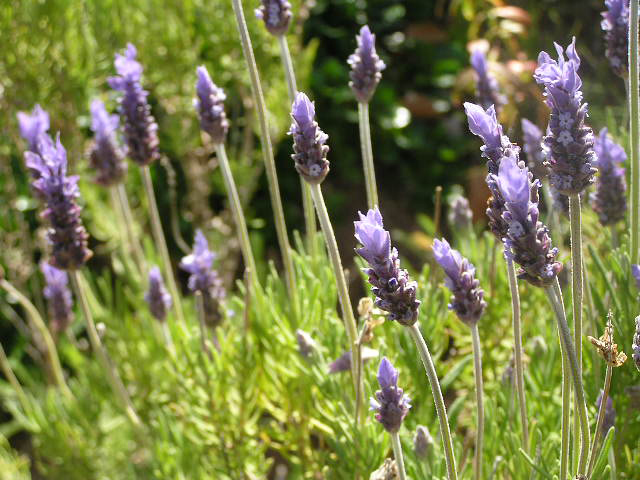
For centuries, gardeners have been observing how various plants can be impacted by their vegetative neighbors. In the vegetable garden, our great-great-grandparents passed on their discoveries that tomatoes and basil get on together a lot better than, say, onions and beans. And so experiential wisdom has been passed through the generations. With new chemicals and mass marketing, some of these basic observations have been overlooked in recent decades. But with the undeniable changes impacting Southern California weather and gardening, we are rediscovering the advantages of companion planting—wisdom that has been scientifically proven over time, attributing chemical reactions as well as physical soil improvements and even the attraction of beneficial organisms to the pairing of symbiotic plants.
Here are some companion plant combinations that help our favorite Southern California edibles thrive with a little help from the neighboring plants we choose for them.

Pair artichokes with peas and sunflowers for nutrient support and sun relief
Artichokes grow happily as big, bold, architectural plants in our local gardens. Their huge buds cook into unique, nutritious meals when steamed, while some can be left on the plant to open as gorgeous, electric indigo-tipped, paintbrush-like flowers. To give your artichoke a boost of nitrogen, plant peas around its base and allow the peas’ vining stems to wind through the stately artichoke plant. You can also add tall sunflowers (Helianthus annuus cvs., annual), a non-nutrient-competitor, on the west-facing side of your artichokes to provide some dappled shade in hot, inland gardens.

Chase tomatillo insect pests away with a mix of vegetables and herbs
Tomatillos are favorites in Hispanic recipes and, though related to tomatoes, are even happier than their cousins to bask in our intense summer sun. Surround them with friendly onions, peppers, and peas to chase away insect pests. Basil, parsley, and colorful nasturtiums (Tropaeolum majus cvs., annual) also make helpful neighbors that repel bad bugs and attract good bugs and pollinators.
Combine squash and marigolds to keep squash bugs at bay
Squashes are super-easy, prolific, and ideal growers in SoCal. Our long growing season is perfect for big crops of winter squash, while summer squashes bask in our bright sunshine and fruit abundantly. What are not welcome are squash bugs, aphids, and other pest insects. Interplanting marigolds (Tagetes spp. and cvs., annual) will add a colorful touch to the garden while discouraging those enemies. To combat destructive squash bugs specifically, plant tansy (Tanacetum vulgare and cvs., Zones 3–8).

Tomatoes and asparagus help protect each other
Here’s an interesting pair of well-loved edibles that have a mutual caregiving relationship. Asparagus plants repel our local tomato nematodes, while tomato plants discourage asparagus beetles. Partner them both with cilantro, parsley, and basil, and both will also benefit with fewer worms, flies, beetles, and aphids.
Onions and garlic paired with many vegetables will help deter pocket gophers
Onions and garlic love SoCal. They have been cultivated here and shipped all over the country for a century. Besides being culinary staples, they have other benefits. Our ravenous pocket gophers are less interested in them than most other plants, and their scent repels many insects that damage tomatoes, eggplants, and brassicas (cabbage, kale, broccoli, etc.). Keep peas, beans, asparagus, and sage away from them, though. Garlic has been known to harm beneficial bacteria on beans and sage.

Colorful flowers draw in wanted pollinators
Adding flowering plants to your vegetable garden is beneficial too. Flowers add color and attract pollinators. Three easy-to-grow annuals are marigolds, petunias (Petunia cvs., annual), and nasturtiums. (All parts of nasturtium are also edible.) They will cheer up the vegetable garden and attract pollinators while discouraging hornworms, aphids, beetles, and a host of other pests. Marigolds additionally attract hoverflies, native pollinators in SoCal. Nasturtiums will help keep hordes of slugs and snails from attacking tall growing vegetables too.

Many herbs make excellent companion plants
You have probably noticed that herbs show up a lot as recommended companion plants. Strongly scented plants often repel pests. Here is a quick reference for the services they can provide—while offering their flavorful, scented leaves for multiple uses in the kitchen, throughout your home, and, of course, in the garden. All do well in our lean soils, and most of them thrive in our strong sunshine or partial shade. Try some of these as repellents for bothersome insect and critter pests too.
- Hyssop (Agastache foeniculum and cvs., Zones 5–9)
- Lavender (Lavandula spp. and cvs., Zones 5–9)
- Mint (Mentha spp. and cvs., Zones 4–9)
- Catnip (Nepeta spp. and cvs., Zones 3–8)
- Sage (Salvia officinalis and cvs., Zones 4–8)
- Rosemary (Salvia rosmarinus and cvs., Zones 8–10)
Here in Southern California, most soils are dry and calcareous. Wind is also drying, and over the years, water supplies have been dwindling—despite a few winters that started with plentiful precipitation. We need to give our plants every chance to grow well. And with the cost and availability issues at grocery stores these days, why not focus on helping our food plants help each other—and us?
—Jane Gates has more than 35 years of professional experience designing and gardening in Los Angeles and is the author of All the Garden’s a Stage: Choosing the Best Performing Plants for a Sustainable Garden.


















Comments
Log in or create an account to post a comment.
Sign up Log in